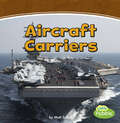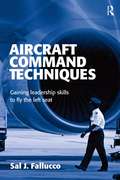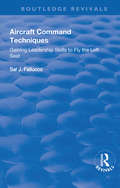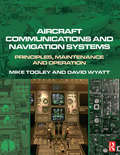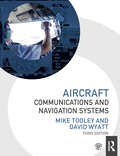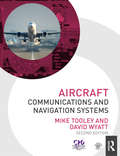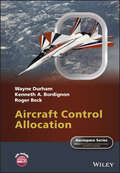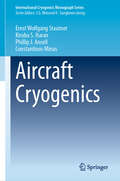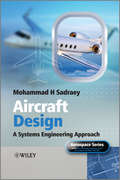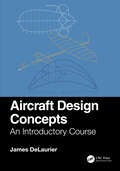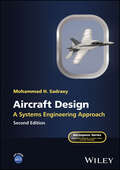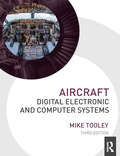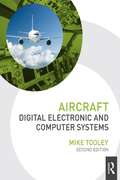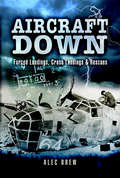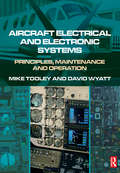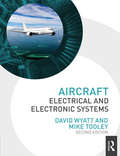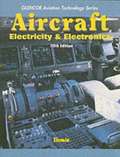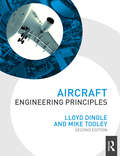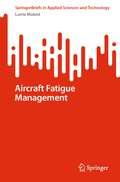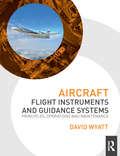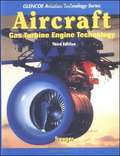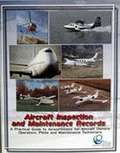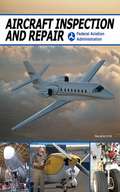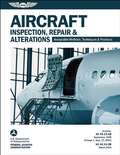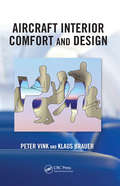- Table View
- List View
Aircraft Carriers: A 4d Book (Mighty Military Machines Ser.)
by Matt ScheffWith flight decks and full facilities, aircraft carriers are hard-working warships ready to support any battle. Take to the sea to learn all about the military's decked-out floating airbases. Little Pebble books have an ATOS level of 1.0 or below. Bring augmented reality to your students by downloading the free Capstone 4D app and scanning for access to awesome videos!
Aircraft Command Techniques: Gaining Leadership Skills to Fly the Left Seat (Routledge Revivals Ser.)
by Sal J. FalluccoA captain must be able not only to fly the aircraft, but also to manage it, manage the crew, and above all, manage his or her resources. In a number of air carriers there may be less than adequate additional training conducted, when upgrading pilots to the very responsible position of captain. However, three things that do not change are the authority, challenges, and responsibilities of being captain. They are as constant today as they will be in the years ahead. Aircraft Command Techniques is a comprehensive examination of the characteristics of the experienced captain. Each chapter begins with an appropriate and relevant anecdote that is analogous to the chapter’s main theme. It then progresses to the chapter’s main objective and finishes with a scenario that the reader is asked to solve from a captain’s perspective using a number of considerations that are offered and should be evaluated when solving the problem. The intent is to help the pilot practise thinking as a captain. Offering a wealth of practical guidance, this book is an ideal platform for pilots or indeed anyone interested in how leadership and management skills are used to achieve excellence. The reader will gain important command skills and will learn how to apply these skills to routine and unexpected situations, in the same way as an experienced captain. The intended readership includes those worldwide in aviation universities and flight schools, in major airlines, in regional and cargo airlines, pilots upgrading to captain and those interested in leadership skill development.
Aircraft Command Techniques: Gaining Leadership Skills to Fly the Left Seat (Routledge Revivals)
by Sal J FalluccoThis title was first published in 2002: A comprehensive examination of the characteristics of the experienced captain. Each chapter begins with an appropriate and relevant anecdote that is analogous to the chapter's main theme. It then progresses to the chapter's main objective and finishes with a scenario that the reader must try to solve from a captain's perspective. Immediately following each of these scenarios, the reader is presented with a number of considerations that should be evaluated when solving the problem. The intent is to help the pilot practice thinking as a captain. Offering a wealth of practical guidance, this book is an ideal platform for pilots or indeed, anyone interested in how leadership and management skills are used to achieve excellence. The reader should gain important command skills and learn how to apply these skills to routine and unexpected situations, in the same way in which an experienced captain would.
Aircraft Communications and Navigation Systems
by David Wyatt Mike TooleyButterworth-Heinemann’s Aircraft Engineering Principles and Practice Series provides students, apprentices and practicing aerospace professionals with the definitive resources to advance their aircraft engineering maintenance studies and career. This book provides an introduction to the principles of communications and navigation systems. It is written for anyone pursuing a career in aircraft maintenance engineering or a related aerospace engineering discipline, and in particular will be suitable for those studying for licensed aircraft maintenance engineer status. The book systematically addresses the relevant sections (ATA chapters 23/34) of modules 11 and 13 of part-66 of the EASA syllabus. It is ideal for anyone studying as part of an EASA and FAR-147 approved course in aerospace engineering.
Aircraft Communications and Navigation Systems
by David Wyatt Mike TooleyIntroducing the principles of communications and navigation systems, this book is written for anyone pursuing a career in aircraft maintenance engineering or a related aerospace engineering discipline, and in particular will be suitable for those studying for licensed aircraft maintenance engineer status. It systematically addresses the relevant sections (Air Transport Association of America chapters 23/34) of modules 11 and 13 of part-66 of the European Aviation Safety Agency (EASA) syllabus and is ideal for anyone studying as part of an EASA and FAR-147-approved course in aerospace engineering. Delivers the essential principles and knowledge base required by Airframe and Propulsion (A&P) Mechanics for Modules 11 and 13 of the EASA Part-66 syllabus and BTEC National awards in aerospace engineering Supports mechanics, technicians and engineers studying for a Part-66 qualification Comprehensive and accessible, with self-test questions, exercises and multiple choice questions to enhance learning for both independent and tutor-assisted study Additional resources and interactive materials are available at the book's companion website at www.66web.co.uk This new and updated third edition provides readers with an overview of the latest key technologies that underpin the functioning of safety-critical systems such as those used in flight management, reporting, navigation, and air traffic control.
Aircraft Communications and Navigation Systems, 2nd ed: Principles, Maintenance And Operation
by David Wyatt Mike TooleyIntroducing the principles of communications and navigation systems, this book is written for anyone pursuing a career in aircraft maintenance engineering or a related aerospace engineering discipline, and in particular will be suitable for those studying for licensed aircraft maintenance engineer status. It systematically addresses the relevant sections (Air Transport Association of America chapters 23/34) of modules 11 and 13 of part-66 of the European Aviation Safety Agency (EASA) syllabus and is ideal for anyone studying as part of an EASA and FAR-147-approved course in aerospace engineering. Delivers the essential principles and knowledge base required by Airframe and Propulsion (A&P) Mechanics for Modules 11 and 13 of the EASA Part-66 syllabus and BTEC National awards in aerospace engineering Supports mechanics, technicians and engineers studying for a Part-66 qualification Comprehensive and accessible, with self-test questions, exercises and multiple choice questions to enhance learning for both independent and tutor-assisted study Additional resources and interactive materials are available at the book's companion website at www.66web.co.uk
Aircraft Control Allocation (Aerospace Series)
by Wayne Durham Roger Beck Kenneth A. BordignonAircraft Control Allocation Wayne Durham, Virginia Polytechnic Institute and State University, USA Kenneth A. Bordignon, Embry-Riddle Aeronautical University, USA Roger Beck, Dynamic Concepts, Inc., USA An authoritative work on aircraft control allocation by its pioneers Aircraft Control Allocation addresses the problem of allocating supposed redundant flight controls. It provides introductory material on flight dynamics and control to provide the context, and then describes in detail the geometry of the problem. The book includes a large section on solution methods, including 'Banks' method', a previously unpublished procedure. Generalized inverses are also discussed at length. There is an introductory section on linear programming solutions, as well as an extensive and comprehensive appendix dedicated to linear programming formulations and solutions. Discrete-time, or frame-wise allocation, is presented, including rate-limiting, nonlinear data, and preferred solutions. Key features: Written by pioneers in the field of control allocation. Comprehensive explanation and discussion of the major control allocation solution methods. Extensive treatment of linear programming solutions to control allocation. A companion web site contains the code of a MATLAB/Simulink flight simulation with modules that incorporate all of the major solution methods. Includes examples based on actual aircraft. The book is a vital reference for researchers and practitioners working in aircraft control, as well as graduate students in aerospace engineering.
Aircraft Cryogenics (International Cryogenics Monograph Series)
by Ernst Wolfgang Stautner Kiruba S. Haran Phillip J. Ansell Constantinos MinasThis book gives a step-by-step approach to the design of a cryogenic infrastructure required for superconducting, all-electric aircraft systems which is also partially applicable to liquid hydrogen fueled subsonic and hypersonic aircraft, as well as hybrids. While there is no shortage of publications on hydrogen fueled aircraft, this book puts the past journal literature through a magnifying glass and condenses it into an engineering strategy for the next steps to enable liquid hydrogen storage and distribution in aircraft. Emphasis is placed on tank design, manufacturability, safety features, and minimum tank weight, providing a holistic focus on the logistics of hydrogen management for all major components within the aircraft as well as on future superconducting motor architecture. The intention is to fully exploit the benefits of a liquid hydrogen reservoir without any need for additional cryogenic fluids, with relevance to cooling of various superconducting components e.g., motors and superconducting cables, as well as the heat sinking of power electronics and for fueling the fuel cell stack system. A liquid hydrogen tank hold-time analysis reveals the main governing factors and describes the required efforts for minimizing onboard boil off for aircraft designs with different flight mission duration. This is followed by an outlook showing where cryotankage technology and cryogenic aircraft architecture may move within the next 20 years embedded in a green hydrogen-based economy and how basic research will need to play a major role to help us realizing these future designs by consequently eliminating whitespace within today's technology landscape. This book is also an aircraft engineering resource on composites, hydrogen properties, general aircraft materials and safety.
Aircraft Design
by Mohammad H. SadraeyA comprehensive approach to the air vehicle design process using the principles of systems engineeringDue to the high cost and the risks associated with development, complex aircraft systems have become a prime candidate for the adoption of systems engineering methodologies. This book presents the entire process of aircraft design based on a systems engineering approach from conceptual design phase, through to preliminary design phase and to detail design phase.Presenting in one volume the methodologies behind aircraft design, this book covers the components and the issues affected by design procedures. The basic topics that are essential to the process, such as aerodynamics, flight stability and control, aero-structure, and aircraft performance are reviewed in various chapters where required. Based on these fundamentals and design requirements, the author explains the design process in a holistic manner to emphasise the integration of the individual components into the overall design. Throughout the book the various design options are considered and weighed against each other, to give readers a practical understanding of the process overall. Readers with knowledge of the fundamental concepts of aerodynamics, propulsion, aero-structure, and flight dynamics will find this book ideal to progress towards the next stage in their understanding of the topic. Furthermore, the broad variety of design techniques covered ensures that readers have the freedom and flexibility to satisfy the design requirements when approaching real-world projects.Key features:* Provides full coverage of the design aspects of an air vehicle including: aeronautical concepts, design techniques and design flowcharts* Features end of chapter problems to reinforce the learning process as well as fully solved design examples at component level* Includes fundamental explanations for aeronautical engineering students and practicing engineers* Features a solutions manual to sample questions on the book's companion websiteCompanion website - www.wiley.com/go/sadraey
Aircraft Design Concepts: An Introductory Course
by James DeLaurierAircraft Design Concepts: An Introductory Course introduces the principles of aircraft design through a quantitative approach developed from the author’s extensive experience in teaching aircraft design. Building on prerequisite courses, the text develops basic design skills and methodologies, while also explaining the underlying physics. The book uses a historical approach to examine a wide range of aircraft types and their design. Numerous charts, photos, and illustrations are provided for in-depth view of aeronautical engineering. It addresses conventional tail-aft monoplanes, "flying-wing", biplane, and canard configurations. Providing detailed analysis of propeller performance, the book starts with simple blade-element theory and builds to the Weick method. Written for senior undergraduate and graduate students taking a single-semester course on Aircraft Design or Aircraft Performance, the book imparts both the technical knowledge and creativity needed for aircraft design.
Aircraft Design: A Systems Engineering Approach (Aerospace Series)
by Mohammad H. SadraeyLearn the aircraft design process from a systems-engineering perspective, designed for both aspiring and practicing aerospace engineers Aircraft design incorporates a range of technological areas, including aerodynamics, flight dynamics, propulsion, and structure. Aircraft engineering design therefore requires techniques from systems engineering to integrate the requirements from these disparate areas into a coherent whole. There has never been a greater need for successful aerospace engineers to have a grasp of systems engineering and its applications in the field. Aircraft Design: A Systems Engineering Approach meets this need with a volume which takes the reader from conceptual design to detail design. Offering a systems engineering approach that weighs the needs of different aircraft components holistically, it provides readers with a practical look into the process of aircraft design. Now fully updated to reflect the latest industry developments, it promises to continue as an indispensable tool for modern students in the field. Readers of the second edition of Aircraft Design will also find: Brand new material on structural design, spoiler design, winglets, aircraft modification and modernization, and more Detailed discussion of emerging topics including all-electric aircraft design, VTOL aircraft design, and many others Guidance on the latest FAA requirements with a design impact Aircraft Design is ideal for senior undergraduate and graduate students interested in aircraft design, advanced aircraft design, and air vehicle design. The book may also be of interest to mechanical, industrial, and systems engineers working in the aerospace sector.
Aircraft Digital Electronic and Computer Systems
by Mike TooleyAircraft Digital Electronic and Computer Systems is a thorough introduction to the principles and practice of aircraft digital electronic, avionic and computer systems. New to this third edition, integrated modular avionics (IMA) provides an overview of networked avionics found in the latest generation of transport aircraft. Cabin systems covers cabin networks, intercommunication, and core systems. Aircraft information systems examines flight deck operation aided by electronic flight bags (EFB) and includes a case study that highlights the importance of information systems, as well as the potential consequences of their failure. The new edition contains several hundred test questions, and its companion website, www.66web.co.uk, offers additional resource material. With full coverage of Module 5 and avionics topics in Modules 11 and 13, this book is ideal for those studying towards licensed aircraft maintenance engineer status, both independently and part of an EASA Part-66 or FAR-147 approved course. It will also appeal to those taking City & Guilds, EDEXCEL National or Higher National Units or a First/Foundation Degree in an aerospace related discipline.
Aircraft Digital Electronic and Computer Systems, 2nd ed
by Mike TooleyAn introduction to the principles of aircraft digital and electronic systems, this book is written for anyone pursuing a career in aircraft maintenance engineering or a related aerospace engineering discipline. Suitable for those studying towards licensed aircraft maintenance engineer status as part of an EASA Part-66 or FAR-147 approved course, or those taking Aerospace Engineering City & Guilds modules, EDEXCEL National Units, EDEXCEL Higher National Units or a Degree in aircraft engineering.
Aircraft Down: Forced Landings, Crash Landings and Rescues
by Alec BrewTwenty-three compelling accounts of desperate circumstances and unbelievable survival when planes went down in remote and dangerous locations.When a pilot experiences a sudden loud bang or sudden total silence, he is often faced with the stark choice of the parachute or attempting to get the aircraft down to earth in as few pieces as possible. This book describes twenty-three remarkable and true instances when, for a variety of reasons, all seems lost—but life was not. These life-threatening incidents range through the history of powered flight and all over the globe from Arctic waste to desert sand and from English hillside to coral reef. Within the narrative are moments of humor, despair and utter joy. The author has gleaned his information from a myriad of sources and many personal accounts. For those who love to read of the human spirit and its determination to survive against all odds—this book makes splendid reading.
Aircraft Electrical and Electronic Systems
by David Wyatt Mike TooleyThe Aircraft Engineering Principles and Practice Series provides students, apprentices and practicing aerospace professionals with the definitive resources to take forward their aircraft engineering maintenance studies and career. This book provides a detailed introduction to the principles of aircraft electrical and electronic systems. It delivers the essential principles and knowledge required by certifying mechanics, technicians and engineers engaged in engineering maintenance on commercial aircraft and in general aviation. It is well suited for anyone pursuing a career in aircraft maintenance engineering or a related aerospace engineering discipline, and in particular those studying for licensed aircraft maintenance engineer status. The book systematically covers the avionic content of EASA Part-66 modules 11 and 13 syllabus, and is ideal for anyone studying as part of an EASA and FAR-147 approved course in aerospace engineering.All the necessary mathematical, electrical and electronic principles are explained clearly and in-depth, meeting the requirements of EASA Part-66 modules, City and Guilds Aerospace Engineering modules, BTEC National Units, elements of BTEC Higher National Units, and a Foundation Degree in aircraft maintenance engineering or a related discipline.
Aircraft Electrical and Electronic Systems, 2nd ed: Principles, Operation And Maintenance
by David Wyatt Mike TooleyIntroducing the principles of aircraft electrical and electronic systems, this book is written for anyone pursuing a career in aircraft maintenance engineering or a related aerospace engineering discipline, and in particular will be suitable for those studying for licensed aircraft maintenance engineer status. It systematically addresses the relevant sections of modules 11 and 13 of part-66 of the EASA syllabus, and is ideal for anyone studying as part of an EASA and FAR-147 approved course in aerospace engineering. Delivers the essential principles and knowledge base required by Airframe and Propulsion (A&P) Mechanics for Modules 11 and 13 of the EASA Part-66 syllabus and BTEC National awards in aerospace engineering Supports Mechanics, Technicians and Engineers studying for a Part-66 qualification Comprehensive and accessible, with self-test questions, exercises and multiple choice questions to enhance learning for both independent and tutor-assisted study This second edition has been updated to incorporate: complex notation for the analysis of alternating current (AC) circuits; an introduction to the "all electric aircraft" utilising new battery technologies; updated sensor technology using integrated solid-state technology micro-electrical-mechanical sensors (MEMS); an expanded section on helicopter/rotary wing health usage monitoring systems (HUMS).
Aircraft Electricity and Electronics (5th Edition)
by Thomas K. EisminOne of five texts in Glencoe's Aviation Technology Series, (formerly the Northrop series), Aircraft Electricity and Electronics provides your students with the information they need to perform return-to-service-quality maintenance and repair of aircraft electrical systems. The material covered includes the details necessary for the Federal Aviation Administration certification of Airframe and Powerplants Technicians. The text expands well beyond this basic information, however, providing as in-depth study of both ac and dc systems for virtually all varieties of aircraft. The text takes students through the fundamentals of electron theory and on to the study of aircraft digital control systems. Integrated into the text are various examples of troubleshooting techniques as they apply to aircraft systems. The text also provides details on a variety of general and commercial aircraft electrical/electronic systems, including avionic systems. One of the major changes in this edition is the modernization of material about electrical and electronic equipment to reflect current practices. Coverage of transistors and semiconductors, lighting systems, and nickel cadmium batteries has been updated while troubleshooting techniques using digital and analog meters have been added. This edition includes a Student Study Guide that parallels the text. It provides fill-in-the-blank questions that identify key term, demonstrates applications of mathematical relationships, and validates learning progress by offering multiple-choice questions.
Aircraft Engineering Principles, 2nd ed
by Lloyd Dingle Michael H TooleyAircraft Engineering Principles is the essential text for anyone studying for licensed A&P or Aircraft Maintenance Engineer status. The book is written to meet the requirements of JAR-66/ECAR-66, the Joint Aviation Requirement (to be replaced by European Civil Aviation Regulation) for all aircraft engineers within Europe, which is also being continuously harmonised with Federal Aviation Administration requirements in the USA.The book covers modules 1, 2, 3, 4 and 8 of JAR-66/ECAR-66 in full and to a depth appropriate for Aircraft Maintenance Certifying Technicians, and will also be a valuable reference for those taking ab initio programmes in JAR-147/ECAR-147 and FAR-147. In addition, the necessary mathematics, aerodynamics and electrical principles have been included to meet the requirements of introductory Aerospace Engineering courses. Numerous written and multiple choice questions are provided at the end of each chapter, to aid learning.
Aircraft Fatigue Management (SpringerBriefs in Applied Sciences and Technology)
by Lorrie MolentFatigue occurs under cyclic loading and can significantly degrade the operational capability and safety of metallic aircraft components and structures. This book provides summaries of some metallic aircraft structural integrity issues, innovative but established examples of maintaining operational capability—airworthiness, and assessments of safe in-service fatigue lives. These topics are based on a through-life fatigue management philosophy that ensures safe and continued operation, including during life extensions that are almost inevitably required. This philosophy is underpinned by observations of the behaviour of fatigue cracks in actual structures subjected to realistic service loading conditions. The book includes topics like aircraft design requirements, individual aircraft fatigue loads monitoring, airframe fatigue testing, sources of fatigue-nucleating discontinuities, and prediction of fatigue crack growth from these discontinuities. All these aspects contribute to discussing methods of assuring the structural integrity and operational capability of realistically cracked structures. The book also discusses the exponential behaviour of lead or dominant cracks—those leading to first failure—and the practical significance of differences between fatigue fracture topographies produced under constant amplitude and variable amplitude loading. The book can be a valuable reference for researchers and professionals interested in aircraft fatigue management and allied fields.
Aircraft Flight Instruments and Guidance Systems: Principles, Operations and Maintenance
by David WyattWritten for those pursuing a career in aircraft engineering or a related aerospace engineering discipline, Aircraft Flight Instruments and Guidance Systems covers the state-of-the-art avionic equipment, sensors, processors and displays for commercial air transport and general aviation aircraft. As part of a Routledge series of textbooks for aircraft-engineering students and those taking EASA Part-66 exams, it is suitable for both independent and tutor-assisted study and includes self-test questions, exercises and multiple-choice questions to enhance learning. The content of this book is mapped across from the flight instruments and automatic flight (ATA chapters 31, 22) content of EASA Part 66 modules 11, 12 and 13 (fixed/rotary-wing aerodynamics, and systems) and Edexcel BTEC nationals (avionic systems, aircraft instruments and indicating systems). David Wyatt CEng MRAeS has over 40 years’ experience in the aerospace industry and is currently Head of Airworthiness at Gama Engineering. His experience in the industry includes avionic development engineering, product support engineering and FE lecturing. David also has experieince in writing for BTEC National specifications and is the co-author of Aircraft Communications & Navigation Systems, Aircraft Electrical & Electronic Systems and Aircraft Digital Electronic and Computer Systems.
Aircraft Gas Turbine Engine Technology (3rd Edition)
by Irwin E. TreagerAircraft Gas Turbine Engine Technology provides a comprehensive, easy-to-understand treatment of the background, development, and applications of the gas turbine engine it its various forms, such as turobjet, turbofan, turboprop, and turboshaft powerplants. Designed primarily as a resource for technicians preparing for the FAA aircraft powerplant mechanic certification, Aircraft Gas Turbine Engine Technology also may be used a reference. The text also discusses the changing maintenance and overhaul procedures and philosophies and the role of fuel metering in engine operation.
Aircraft Inspection And Maintenance Records: A Practical Guide To Airworthiness For Aircraft Owners, Operators, Pilots, And Maintenance Technicians
by JeppesenA practical guide to airworthiness for maintenance technicians, aircraft owners, operators, and pilots. This completely rewritten and revised fourth edition is much more than a simple introduction, this book is actually a reference, technical manual, and textbook rolled into one. Packed with photos, checklists, and concrete maintenance entries, Aircraft Inspections & Maintenance Records is an essential reference for industry professionals, students, and flying enthusiasts. Four new additional chapters incorporate many updated topics such as airworthiness determination inspection and maintenance documentation and record entries, and PIC airworthiness checks and responsibilities.
Aircraft Inspection and Repair: Acceptable Methods, Techniques, And Practices (FAA Handbooks Ser.)
by Federal Aviation AdministrationWith every deadly airplane disaster or near-miss, it becomes more and more clear that proper inspection and repair of all aircraft is essential to safety in the air. When no manufacturer repair or maintenance instructions are available, the Federal Aviation Administration deems Aircraft Inspection and Repair the one-stop guide to all elements of maintenance: preventive, rebuilding, and alteration. With detailed information on structural inspection, protection, and repair, including aircraft systems, hardware, fuel and engines, and electrical systems, this comprehensive guide is designed to leave no vital question on inspection and repair unanswered. Sections include: Wood, fabric, plastic, and metal structures Testing of metals and repair procedures Welding and brazing, including fire explosion and safety Nondestructive inspection (NDI) Application of magnetic particles Common corrosive elements and corrosion proofing Aircraft hardware, from nuts and bolts to washers and pins Engines, fuel, exhaust, and propellers Aircraft systems and components Electrical systems This is a book that should be available to everyone who works on aircraft or is training to do so. The official FAA guide to maintenance methods, techniques, and practices-essential for all pilots and aircraft maintenance workers. 200 B&W 200 B&W
Aircraft Inspection, Repair and Alterations: Acceptable Methods, Techniques and Practices (FAA Ac 43. 13-1b/2b) (FAA Handbooks)
by Federal Aviation Administration (FAA)/Aviation Supplies and Academics (ASA) StaffThis handbook for Aviation Maintenance Technicians (AMTs), repair stations, aircraft owners and homebuilders details the standards for acceptable methods, techniques, and practices for the inspection, repair, and alteration of aircraft. It is a combination of the two most important Advisory Circulars (ACs) written by the Federal Aviation Administration (FAA) on this topicnamely, "Acceptable Methods, Techniques, and Practices: Aircraft Inspection and Repair" (AC 43.13-1B) and "Acceptable Methods, Techniques and Practices: Aircraft Alterations" (AC 43.13-2B) -- printed and bound into one volume and called the "AC 43.13-1B/2B." AC 43.13-1B provides details on the materials and practices, health and safety, inspection, repair, and finishes for wood structures, fabric covering, fiberglass and plastics, and metal structures, welding and brazing. It includes chapters dedicated to nondestructive inspection (NDI), corrosion, inspection and protection, aircraft hardware, control cables and turnbuckles, engines, fuel, exhaust, propellers, aircraft systems and components, weight and balance, electrical systems, avionics, and human factors. AC 43.13-2B is a manual filled with details and instructions for the installation of aircraft components and systems, such as communications, navigation, and emergency systems, anticollision and supplementary lights, skis, oxygen systems in nonpressurized aircraft, rotorcraft external-load devices, cargo slings and external racks, glider and banner tow-hitches, aircraft batteries and more, including guidance on adding or relocating instruments. These combined manuals provide this pertinent information where no manufacturer repair or maintenance instructions exist. The details and standards for methods and practices covered are applicable to non-pressurized civil aircraft with a gross weight of 12,500 pounds or less. Illustrated throughout; includes a glossary, and a list of useful acronyms and abbreviations.
Aircraft Interior Comfort and Design (Ergonomics Design & Mgmt. Theory & Applications)
by Peter VinkWhat should every airline and manufacturer know about comfort?What can we learn from studies in the scientific literature?What do most passengers know about comfort and how can we translate that into interior design?Where can I find the latest knowledge and research useful for designing aircraft seats?Although the answers to these questions are ava
